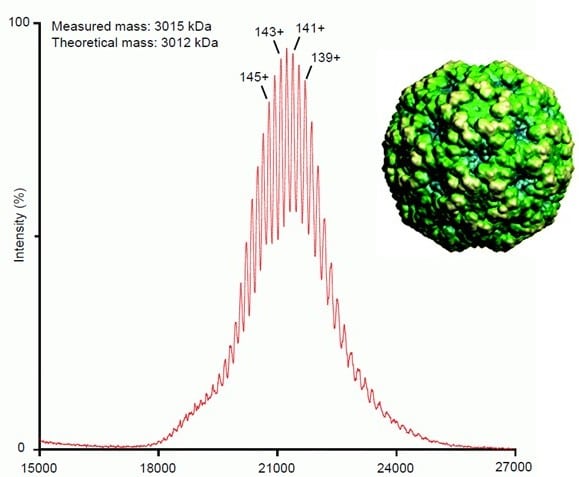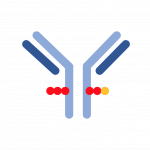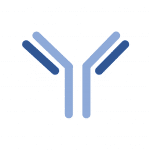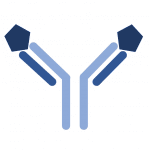Native Mass Spectrometry
Native mass spectrometry (native MS) is simply a process to allow large molecules, most often large biomolecules, proteins, viruses etc. either on their own or as complexes with other molecules to be transferred from a solution into the gas phase while maintaining the three-dimensional structure of the target molecule or complex. The aim is to do this in such a manner as to preserve any non-covalent interactions. The purpose of these experiments is most often the observation of these non-covalent interactions to better understand the biological processes being studied. A useful overview of Native MS can be found here. A list of other useful resources can be found at the end of this introduction.
By preserving these molecules in their native state we introduce a number of challenges or observing them in a mass spectrometer. Of most significance is that by maintaining the natural folded state of the molecule the number of sites available to receive a charge is reduced and subsequently the mass-to-charge ratio (m/z) is shifted usually beyond the standard range of most mass spectrometers. The most widely used instruments are Q-ToF based. This is largely due to their suitability for studying these types of interactions but also because of their wide availability and ease of modification as well as particularly due to their theoretically unlimited mass range.

MS Vision and Native MS
Since 2005 MS Vision has been active in the field of Native Mass Spectrometry and has fulfilled a pioneering role in the development of the technique. By our own R&D and in close collaboration with the group of Prof. Albert Heck at Utrecht University, we could build up a unique expertise in high mass and native mass spec and have gradually and steadily improved the technology for the analysis of intact protein complexes, often non-covalently bound, preserving native conditions in the gas phase. Native mass spectrometry is at the core of what we do! We develop and support these systems since the foundation of our company more than 15 years ago.
In the context of our R&D projects such as SuperMaMa we are continuously striving for further improvements in the fields such as increased quadrupol mass ranges. So, expect even further expanded capabilities in the future!
Today we can offer these capabilities on a range of instruments from simple time of flight instruments (Waters LCT series) through standard Q-Tof (Waters Q-Tof series) to the latest ion mobility enabled Q-Tofs (Waters Synapt series). If you are interested in modifying an instrument you own or if you would be interested in purchasing a pre-modified system please contact us. A useful overview of the requirements for Native MS can be found in the paper Native mass spectrometry—A valuable tool in structural biology from Carla Schmidt and Marie Barth.
Applications:

PTM/heterogeneity analysis

- Extension of the quadrupole m/z range to 32 kDa, enabling efficient transmission and selection of large protein complexes
- Enhanced control over ion source and transfer region conditions, allowing for softer operation for better preservation of fragile proteins, and hotter conditions for enhanced activation of stable complexes
- Preserving the Ion Mobility capability of the instrument
- Customized acquisition settings, for best signal-to-noise in real-time monitoring
- Enhanced activation and collisional cooling control in the TriWave region, allowing the admission of different gases into the IMS stage so it can either be used for post-activation cooling or Ion Mobility.
Turning the Synapt into a Native Electrospray MS platform
The interest in MS of large biomolecules and biomolecular complexes has increased in recent years. Mass spectrometric study of intact proteins and their function in non-covalently bound complexes is providing more information about complicated biological systems. It is well known that intact large protein complexes can be transferred into the gas phase using nano-electrospray ionisation under native conditions, but subsequent MS or MS/MS analysis is prohibited by mass-scale, ion transmission or ion thermalisation limitations on standard instrumentation. These limitations have now been overcome, and all analytical tools available on the Synapt can be fully exploited in the study and analysis or large proteins and their complexes.
MS Vision’s NativeSynapt opens the door to Mass Spectrometric studies of large, non-convalent protein complexes. It offers enhanced sensitivity for high mass species and allows tandem MS on precursor ions up to 30,000 m/z, turning proven Q-Tof technology into a unique instrument capable of producing groundbreaking results.
Making it work better
By careful consideration of the conditions that exist in the consecutive sections of the instrument, the performance of the Synapt for large ions can be improved considerably by changing the characteristics of the ion optical elements.
Nearly every aspect of the instrument has been optimized for high mass work. Source pressure is increased to allow better collisional cooling of the energetic, multiply charged ions. RF amplitudes in the transfer region are reduced to prevent RF breakdown. The quadrupole mass range is 30,000 and the maximum collisional energy has doubled to 400V. The collision cell operates at much higher pressures for better fragmentation and collisional cooling. Finally, the TOF mass range is no longer limited to 30,000.
In order to improve control over the crucial pressures in the source and collision cell, high quality gas- and vacuum handling equipment has been added along with localized pressure monitoring. The result of all this is an instrument which routinely gives you high mass performance you didn’t know could be achieved.
No compromise
All functionality of the original instrument is available on the NativeSynapt. Simply choose between modes and analyze your samples. Soft conditions for preservation of complexes, high energy dissociation, Ion Mobility – it’s all possible!
Upgrade or full instrument
Whether you want to have your own Synapt upgraded or need a complete instrument, MS Vision has the solution. We offer full support by our highly skilled engineers so you can concentrate on running your samples.

- Extension of the quadrupole m/z range to 10.000 Da, enabling efficient transmission and selection of biologics under native conditions
- Extension of Orbitrap detection mass range to 10.000 m/z to fully cover the mass range of biologics under native MS conditions
- Improved fragmentation due to pulsed gas valve at HCD cell
- Optional charge reduction for simplifying deconvolution and isoform isolation
- Optical access for future UVPD or IRMPD upgrade options
Turning QExactive into a biologics characterization platform
The interest in MS of large biomolecules and biomolecular complexes has increased in recent years and many of the new pharmaceutical drugs are biologics or NBE’s. Mass spectrometry plays a central role in their characterization to provide insights into structure, function and safety.
MS Vision’s new NativeQE now offer the functionality to characterize monoclonal antibodies, ADC’s or other complex biologics at high mass spectrometric resolution opens. See all the isoforms and isolate them for individual analysis. The high isolation limit of 10.000 m/z allows you to get top-down information from every single charge state or glyco-isoform.
The improved HCD cell with pulsed as valve and optional UVPD laser coupling at the same time provides more efficient fragmentation for complete characterization.
Making it work better
We wanted to transfer the knowledge we gained by modifying Waters QTOF instruments for 20 years to the Thermo QExactive platform. This involved changes in ionisation, ion transfer, ion selection, fragmentation and detection as well as in the software.
All this took us much longer than we originally expected, but finally it’s there. The NativeQE covers most of the aspects current instrument users in biopharma were missing on the platform. MS Vision’s upgrade now adds the capabilities which are really needed by biopharma customers.
No compromise
All functionality of the original instrument is available on the NativeQE. Simply choose between modes and analyze your samples. Soft conditions for preservation of complexes, high energy dissociation, nativeMS, top-down – it’s all possible!
Upgrade or full instrument
Whether you want to have your own QExactive upgraded or need a complete instrument, MS Vision has the solution. We offer full support by our highly skilled engineers so you can concentrate on running your samples.




